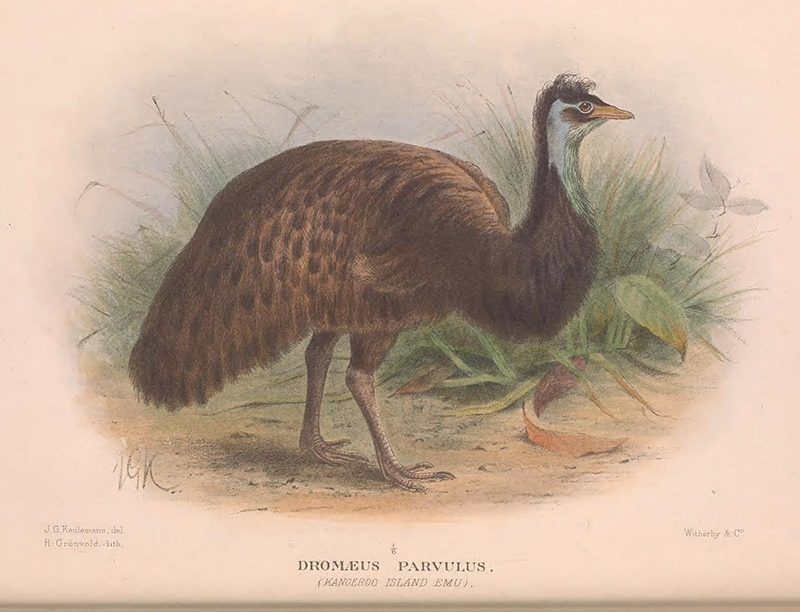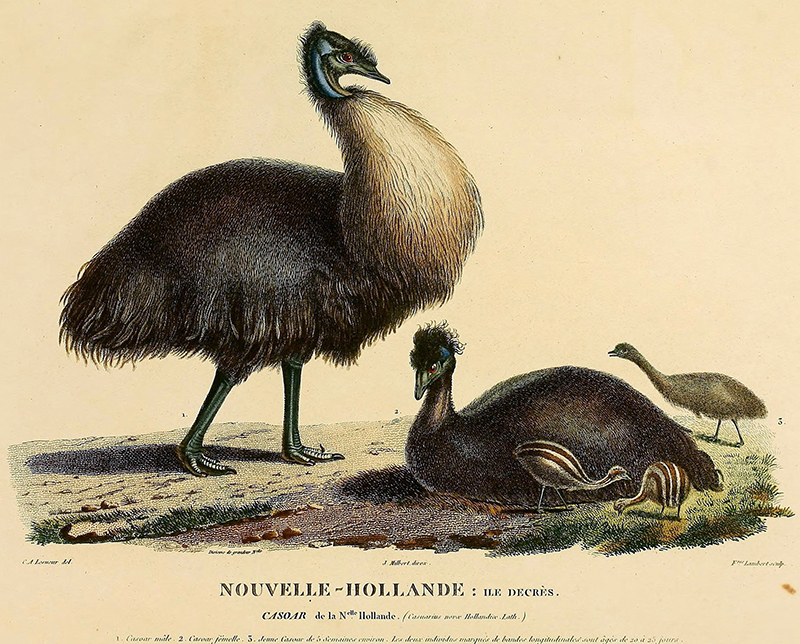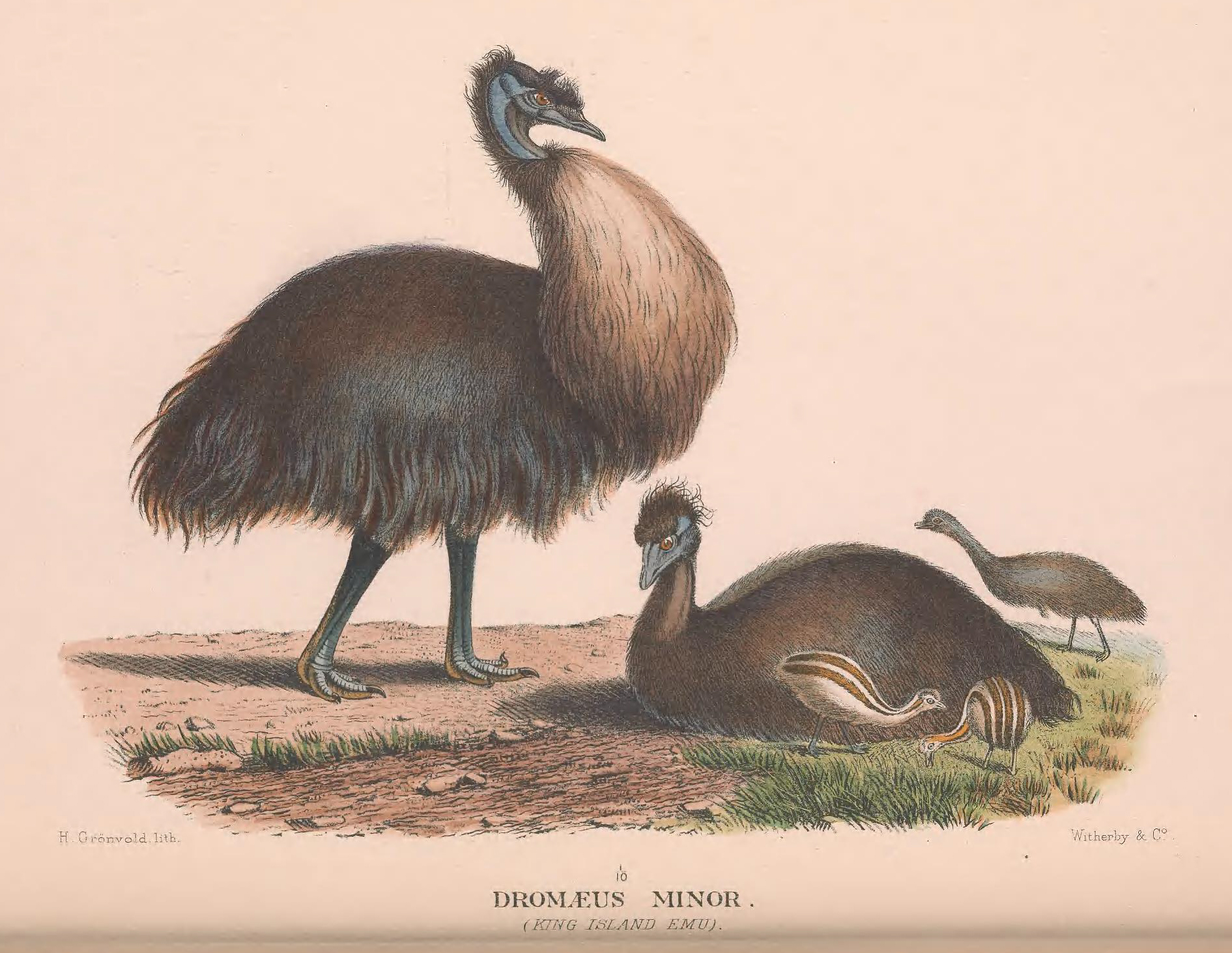Dromaius novaehollandiae baudinianus Parker, 1984:20
Kangaroo Island emu
Taxonomy & Nomenclature
Synonym/s: Dromaius baudinianus Parker, 1984:20; Dromaius diemenianus Jennings, 1828; Dromaeus parvulus Mathews, 1901; Dromaius peroni Rothschild, 1907; Peronista peroni Mathews, 1913; Dromaius baudinus Parker, 1984
Conservation Status
Extinct (WCMC, 1992:211)
Last record: 1803 (WCMC, 1992:211); between 1802 and 1836 (c.1824 going by Leigh, 1982); 1827 (Anonymous, 1994); 1830 (Kittelberger et al., 2024)
IUCN RedList status: Extinct
The last record of this species is generally cited as being 1827. However, Leigh (1982) landed on Kangaroo Island in 1836 and remarked that the species had been exterminated "some 12 years previously" (fide Walshe, 2014:133-134).
Distribution
Kangaroo Island, South Australia, Australia
Biology & Ecology
Hypodigm
There is a unique egg in the Tring Museum (Mason, 1935; Hume & Walters, 2012:21).
Media

Above: coloured plate by J. G. Keulemans, published in (Mathews, 1910-1911:pl.3)

Above: an illustration by Charles-Alexandre Lesueur (c.1808-1811). Possibly depicting a Kangaroo Island emu (standing) and King Island emu (laying down) (see Pfennigwerth, 2010). Source: Wikimedia Commons.

Above: illustration by Henrik Grønvold based upon the one above by Charles-Alexandre Lesueur, published in (Mathews, 1910-1911:pl.4).
References
Original scientific description:
Parker, Shane Alwyn. (1984). The extinct Kangaroo Island Emu, a hitherto-unrecognized species. Bulletin of the British Ornithologists' Club 104: 19-22.
Other references:
Anonymous. (1994). Fauna reintroductions in the Australian arid zone: recent update. Wanted Alive 4: 3-4.
Antonius, Edwin. (2017). Emus von King Island und Kangaroo Island in Europa – Neue Erkenntnisse über 1804 von der Baudin-Expedition mitgebrachte Vertreter inzwischen ausgerotteter Laufvögel. Der Zoologische Garten 86(1-6): 41-76. [Abstract]
Ashby, E. (1924). Notes on extinct or rare Australian birds, with suggestions as to some of the causes of their disappearance. Part 1. Emu 23(3): 178-183.
Baxter, C. and Berris, M. (1995). An annotated list of the birds of Kangaroo Island, second edition. [Kingscote]: The National Parks & Wildlife Service. 91 pp. [relevant citation?]
BirdLife International (2000) Threatened Birds of the World. Lynx Edicions and BirdLife International, Barcelona and Cambridge.
BirdLife International. (2012). Dromaius baudinianus. In: IUCN 2012. IUCN Red List of Threatened Species. Version 2012.1. (http://www.iucnredlist.org). Downloaded on 30 September 2012.
BirdLife International. 2016. Dromaius baudinianus. The IUCN Red List of Threatened Species 2016: e.T22724449A94867311. https://dx.doi.org/10.2305/IUCN.UK.2016-3.RLTS.T22724449A94867311.en. Accessed on 02 July 2022.
Blakers, M., Davies, S.JJ.F. and Reilly, P.N. 1984. The Atlas of Australian Birds. Royal Australasian Ornithologist Union. Melbourne University Press, Melbourne.
Boles, Walter E. (1992). Revision of Dromaius gidju Patterson & Rich 1987 from Riversleigh, northwest Queensland, Australia, with a reassessment of its generic position. Contributions to the Los Angeles County Museum of Natural History [1992]: 195-208.
Brasil, L. (1914). The Emu of King Island. Emu 14(2): 88-97.
Brooks, T. 2000. Extinct species. In: BirdLife International (ed.), Threatened Birds of the World, pp. 701-708. Lynx Edicions and BirdLife International, Barcelona and Cambridge, U.K.
Brouwer, J. and Parker, Shane. (1992). Emu (Kangaroo Island subspecies), p. 16. In: Garnett, Stephen (ed.). (1992). Threatened and Extinct Birds of Australia. RAOU Report Number 82. Royal Australasian Ornithologists Union, Melbourne, and Australian National Parks and Wildlife Service, Canberra. 212 pp.
Carpenter, G. and Horton, P. (1999). Birds, pp. 205-224. In: Robinson, A. C. and Armstrong, D. M. (eds.). (1999). A Biological Survey of Kangaroo Island, South Australia, 1989 & 1990. South Australia: Heritage and Biodiversity Section, Department for Environment, Heritage and Aboriginal Affairs.
Christidis, L. and Boles, W.E. 2008. Systematics and Taxonomy of Australian Birds. CSIRO Publishing, Collingwood, Australia.
Cibois, Alice et al. (2019). Genetic and radiographic insights into the only known mounted specimen of Kangaroo Island Emu. Revue suisse de Zoologie 126(2): 209-217.
Condon, H. T. (1967). Kangaroo Island and its vertebrate land fauna. Australian Natural History 15(12): 409-412.
Cooper, H. M. and Condon, H. T. (1947). On some fragments of emu egg-shell from an ancient camp-site on Kangaroo Island. South Australian Ornithologist 18(7): 66-68.
Department of Sustainability, Environment, Water, Population and Communities. (2012). Dromaius baudinianus in Species Profile and Threats Database, Department of Sustainability, Environment, Water, Population and Communities, Canberra. Available from: http://www.environment.gov.au/sprat. Accessed Tue, 19 Jun 2012 00:42:46 +1000.
Fishburn, Matthew. (2022). Dwarf emus from Baudin's voyage (1800–1804): an overlooked engraving by Nicolas Huet (1770–1830). Archives of Natural History 49(2): 285-297. https://doi.org/10.3366/anh.2022.0791
Frith, H. J. (1979). Wildlife Conservation, revised edition. Angus & Robertson. xiv + 416 pp. [p. 56, pl. 59 (between p. 258/259), p. 295, p. 307-308 (species account)]
Garnett, S. T. and Crowley, G. M. (2000). The Action Plan for Australian Birds 2000. Canberra, ACT: Environment Australia & Birds Australia.
Giglioli, H. H. (1907). On the extinct emu of the small islands off the south coast of Australia and probably Tasmania. Nature 75: 534.
Hall, Robert. (1899). A Key to the Birds of Australia and Tasmania ; with their geographical distribution in Australia. Melbourne/London, Melville Mullen & Slade / Dulau & Co.
del Hoyo, J., Collar, N.J., Christie, D.A., Elliott, A. and Fishpool, L.D.C. 2014. HBW and BirdLife International Illustrated Checklist of the Birds of the World. Volume 1: Non-passerines. Lynx Edicions BirdLife International, Barcelona, Spain and Cambridge, UK.
Howchin, W. (1926). Some references to the literature concerning the extinct emus of Kangaroo Island and elsewhere. South Australian Ornithologist 8(7): 244-253.
Hume, Julian Pender. (2017). In search of the dwarf emu: extinct emus of Australian islands. Talk to be presented on Monday 13 March to the British Ornithologists' Club. [Abstract]
Hume, Julian Pender and Robertson, Christian. (2021). Eggs of extinct dwarf island emus retained large size. Biol. Lett. 17: 20210012. https://doi.org/10.1098/rsbl.2021.0012
Hume, Julian Pender and Walters, Michael. (2012). Extinct Birds. London: T & AD Poyser. 544 pp.
Iredale, Tom. (1924). As extinct as the Dodo. The Australian Museum Magazine 2(4): 117-120.
Jennings, J. (1828). Ornithologia; or, The Birds: A Poem, in Two Parts with an Introduction to their Natural History; and Copious Notes. London: Poole and Edwards.
Jouanin, Christian. (1959). Les emeus de l'Expedition Baudin. L'Oiseau et la Revue Française d'Ornithologie 29(3): 169-203.
Kittelberger, Kyle D., Tanner, Colby J., Buxton, Amy N., Prewett, Amira and Şekercioğlu, Çağan Hakkı. (2024). Correlates of avian extinction timing around the world since 1500 CE. Avian Research 15: 100213. https://doi.org/10.1016/j.avrs.2024.100213 [Supplementary data (List of 216 taxa)]
Knox, Alan G. and Walters, Michael P. (1994). Extinct and endangered birds in the collections of The Natural History Museum. British Ornithologists' Club Occasional Publications 1: 1-292.
Lampert, R. J. (1972). A carbon date for the Aboriginal occupation of Kangaroo Island, South Australia. Mankind 8: 223-229.
Leigh, W. H. (1982).Travels and Adventures in South Australia 1836-1838 (facsimile edition). Sydney: Currawong Press.
Marchant, S. and Higgins, P. J. (eds.). 1990. The Handbook of Australian, New Zealand and Antarctic Birds. Oxford University Press, Melbourne.
Mason, Geo E. (1935). On a Hitherto-unrecorded Egg of the Lesser Emu of Kangaroo Island - with a Brief Description Thereof. Emu 35(4): 331-332.
Mathews, Gregory. (1910-1911). The Birds of Australia, volume 1. London: Witherby & Co.
Mathews, Gregory M. (1913). New species and subspecies of Australian birds. Austral Avian Record 2(4): 73-79.
McMichael, Donald F. (1967). The conservation of animals and plants. Australian Natural History 15(12): 423-428.
Moore, H. P. (1924). Notes on the early settlers in South Australia prior to 1836. Proc. R. Geogr. Soc. Aust. S. Aust. Br., 25: 81-135.
Morgan, A. M. and Sutton, J. (1928). A critical description of some recently discovered bones of the extinct Kangaroo Island Emu (Dromaius diemenianus). Emu 28: 1-19.
Parker, Shane Alwyn, Eckert, H. J., Ragless, G. B., Cox, J. B. and Reid, N. C. H. (1979). An Annotated Checklist of the Birds of South Australia. Part One: Emus to Spoonbills. Adelaide: South Australian Ornithological Association.
Pearce, R. L. (1995). French Doctor-Naturalists in Western Australia. Early Days. J. Roy. WA Hist. Soc. 2(1): 56-66.
Péron, François. (1804). Voyage de de couvertes aux terres Australes. Paris.
Pfennigwerth, Stephanie Clare. (2010). “The mighty cassowary”: the discovery and demise of the King Island emu. Archives of Natural History 37(1): 74-90. [Abstract]
Rothschild, Lionel Walter. (1907). Extinct birds: an attempt to write in one volume a short account of those birds which have become extinct in historical times, that is within the last six or seven hundred years: to which are added a few which still exist, but are on the verge of extinction. London: Hutchinson & Co. XXIX + 243 pp. [p. 235-236, pl. 40 (as D. peroni)]
Sayol, Ferran, Steinbauer, Manuel J., Blackburn, Tim M., Antonelli, Alexandre and Faurby, Søren. (2020). Anthropogenic extinctions conceal widespread evolution of flightlessness in birds. Science Advances 6(49): eabb6095. https://doi.org/10.1126/sciadv.abb6095 [Supplementary Material (Data File S1)]
Serventy, D. L. (1967). The Bass Strait Islands. Aust. Nat. Hist. 15: 401-408.
Slater, P. (1978). Rare and Vanishing Australian Birds. Sydney: Rigby.
Spencer, W. Baldwin and Kershaw, J. A. (1910). A Collection of Sub-fossil Bird and Marsupial Remains from King Island, Bass Strait. Mem. Nat. Mus. Melbourne 3: 5-35.
Stattersfield, A.J., Crosby, M.J., Long, A.J. and Wege, D.C. 1998. Endemic bird areas of the world: priorities for bird conservation. BirdLife International, Cambridge, U.K.
Sydney Gazette 5 April 1817
Thomson, Vicki. (2018). Distinct or diminutive?: Were Australia's extinct emus different species? Wildlife Australia 55(3): 5-6. [Abstract]
Thomson, Vicki A., Mitchell, Kieren J., Eberhard, Rolan, Dortch, Joe, Austin, Jeremy J. and Cooper, Alan. (2018). Genetic diversity and drivers of dwarfism in extinct island emu populations. Biology Letters 14(4): 20170617. [Abstract]
Tyrberg, Tommy. (2009). Holocene avian extinctions, pp. 63-106. In: Turvey, Samuel T. (ed.). Holocene Extinctions. Oxford, UK & New York, USA: Oxford University Press. xii + 352 pp.
Vickers-Rich, Patricia. (1975). Antarctic dispersal routes, wandering continents, and the origin of Australia's non-passeriform avifauna. Mem. Nat. Mus. Vic. 36: 63-126.
Walshe, K. (2000). Results of Indigenous Site Survey, Kangaroo Island. Unpublished manuscript on file at Australian Heritage Commission, Canberra. [Walshe, 2014: "Kangaroo Island Emu were also identified from post-cranial remains"]
Walshe, Keryn. (2014). Archaeological Evidence for a Sealer's and Wallaby Hunter's Skinning Site on Kangaroo Island, South Australia. The Journal of Island and Coastal Archaeology 9(1): 130-143. [Abstract]
WCMC (World Conservation Monitoring Centre). (1992). Global Biodiversity: Status of the Earth's living resources. London: Chapman & Hall. xx + 594 pp.
Williams, Dominic L. G. (1980). Catalogue of Pleistocene vertebrate fossils and sites in South Australia. Transactions of the Royal Society of South Australia 104(5): 101-115.
Woinarski, John C. Z., Braby, M. F., Burbidge, A. A., Coates, D., Garnett, S. T., Fensham, R. J., Legge, S. M., McKenzie, N. L., Silcock, J L. and Murphy, B. P. (2019). Reading the black book: The number, timing, distribution and causes of listed extinctions in Australia. Biological Conservation 239: 108261. https://doi.org/10.1016/j.biocon.2019.108261
Woinarski, John C. Z., Legge, Sarah M. and Garnett, Stephen T. (2024). Extinct Australian birds: numbers, characteristics, lessons and prospects. Emu 124(1): 8-20. https://doi.org/10.1080/01584197.2023.2240345
Worthy, Trevor H. and Nguyen, Jacqueline M. T. (2020). An annotated checklist of the fossil birds of Australia. Transactions of the Royal Society of South Australia 144(1): 66-108.
Worthy, Trevor H., Nguyen, Jacqueline M. T. and Travouillon, Kenny J. (2024). Checklist of the Fossil Bird Species of Australia. Available from: https://www.australasianpalaeontologists.com/national-fossil-species-lists [Accessed 24 November 2024]
Worthy, Trevor H., Nguyen, Jacqueline M. T. and Travouillon, Kenny J. (2025). Checklist of the Fossil Bird Species of Australia. Available from: https://www.australasianpalaeontologists.com/national-fossil-species-lists [Accessed 1 March 2025]
http://citeseerx.ist.psu.edu/viewdoc/download?doi=10.1.1.699.6224&rep=rep1&type=pdf
<< Back to the Casuariiformes (Casowaries and Emus) database
